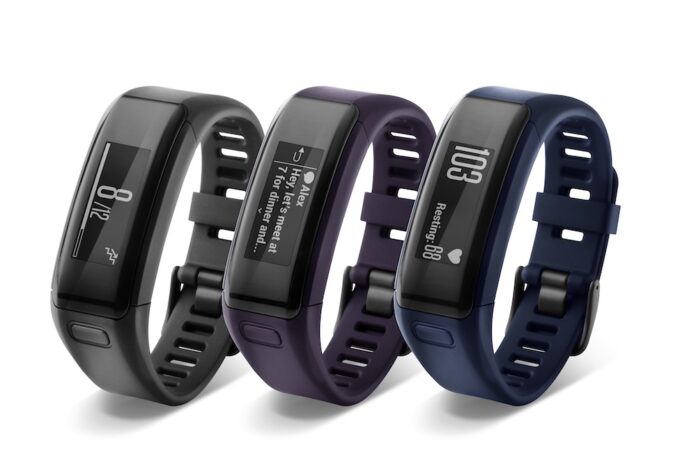If you want to use your fitness tracker to keep tabs on your daily routine, the Garmin Vivosmart HR+ is the device you need. This wristband combines an OLED screen with GPS and accelerometer to track things like distance, pace, calories burned, steps taken, and heart rate. It’s able to do all that without you having to manually input your information, which makes it a great choice for anyone just looking to take charge of their health.
Garmin this week unveiled the latest addition to its fitness-tracking wristband lineup, the Vivosmart HR+. The device is essentially the same as the Vivosmart HR we saw last year, but with a few minor updates, including a new strap and an updated band design that is sleeker and more durable. The Vivosmart HR+ also improves on the heart-rate tracking, thanks to the addition of a new optical heart-rate monitor and an improved optical sensor.
The Vivosmart HR+ is water-resistant to 50M, which means it can withstand splashes from the shower, as well as rain, but it’s not waterproof. The device is also compatible with all of the same apps and third-party
Fitness trackers are a lot of fun and can provide valuable information for those who want to track everything from their steps to their sleep. While there are a number of different options on the market, there are also a number of features and benefits that a particular tracker will have over another. One of the benefits that the Garmin Vivosmart HR+ has over other fitness trackers is the heart rate sensor, which is found on the back of the tracker. This means that you can get accurate data on your heart rate while you run, walk, or swim, without having to wear a chest strap.

Apart from Garmin, nobody seems to have succeeded in developing a fitness tracker. With the Vivosmart HR update, the addition of + and a number of key features, Garmin has cleared the field. (Source: cnet.com) In case you’re wondering, the HR+ does everything you’d expect from a portable device. It sends notifications from your phone about things like incoming calls, texts, emails, etc. if you want. There are rings that do as much, but the HR+ goes a step further. It features fitness tracking, GPS and continuous heart rate monitoring, all in a waterproof case.
The worst thing you can say about it is that it looks like a fitness tracker. It features fitness tracking, GPS and continuous heart rate monitoring, all in a waterproof case. The worst thing you can say about the HR+ is that it looks like a fitness tracker. Ready to sail Keeping track of health data is one of the biggest challenges on the feature list. Most fitness trackers and smartwatches record steps, calories and sometimes heart rate. We come back to the subject of momentum. Many fitness trackers allow users to wear the tracker in the water, but none offer a slimmer body than the HR+.

The Polar A300 works well in water, but it is lost without GPS and does not register a heart rate. Garmin’s Swim smartwatch is clearly designed for swimming, but cannot record heart rate or location. Don’t even think about Jawbone’s waterproofing. The HR+ is perhaps the only fitness tracker of this size that is useful for triathletes. It has no special software to measure laps or other swimming performance. Presumably they will appear later with software updates. with GPS As mentioned earlier, HR+ knows where you are on the planet.
Many fitness trackers can perform this function with a little help from your smartphone. The HR+ does not play music, but users do not need to wear another device to measure their distance traveled. Not to mention that it’s generally not a good idea to immerse your phone in water. To put the functionality of GPS into perspective: The Apple Watch, which FitBit’s CEO criticized for wanting too much, has no GPS. Oh, and Apple doesn’t recommend swimming with your watch.
Heart Rate Monitor So what if he’s got a pulse, right? Trackers and smartwatches have been doing this for years. Whatever you say about the importance of heart rate for the future of wearable devices, right now it’s important for consumers. HR+ monitors your heart rate not only during your run, but at all times. The problem with fitness trackers with continuous heart rate monitoring is battery life. For this reason, you can expect the HR+ to need to be charged daily. No. A charge lasts a week. Even better: You can check this and other data with a simple touch screen.

The HR+ is more visible on your wrist than most dull watches, but not much more than other fitness trackers. It also comes in a nice plastic case, which we’ll probably keep until science figures out how to make other materials light, flexible and waterproof. These complaints aside, there’s no reason why the Garmin Vivosmart HR+ shouldn’t be on your wrist as soon as possible. Actually, it could be. Garmin is selling the HR+ right now.If you’ve been following our site for a while, you know that we’ve been big fans of the Garmin Vivosmart HR+ fitness tracker for a while.
While the fitness-tracking capabilities of Garmin’s older Vivosmart HR have been criticized by some, the HR+ has all the specs you need to do everything you might want to track—steps taken, heart rate, sleep, and more—but it also delivers on Garmin’s promise of offering a more stylish, all-day wearable. And, since it’s a Garmin device, you can always count on the company to deliver on its promise of offering a device that feels like a nice, premium fitness tracker.. Read more about garmin vivosmart 4 and let us know what you think.

Frequently Asked Questions
Is Garmin Vivosmart better than Fitbit?
Back in 2013, Fitbit filed a patent for a line of devices that would measure and display the heartbeat of the wearer, and this turned out to be the company’s first major success in the wearables category. The wearable technology industry was flooded with fitness trackers that utilized the same technology. However, Fitbit has done even better than its original patent application. It has made very significant improvements to its original patent, and now the best of the best are nothing short of amazing.
The Fitbit has been one of the most popular fitness trackers for a long time, but now it’s got a serious contender in the form of the Garmin Vivosmart HR+. Both devices are designed to be worn on your wrist, but the Garmin is a little more sleek and stylish, as well as more versatile. The Vivosmart HR+ comes with a heart rate monitor, GPS, and onboard wireless syncing to your mobile phone, while the Fitbit Flex is only compatible with phone syncing.
What can the Garmin Vivosmart HR do?
Garmin has been making fitness trackers for years that are aimed at the activity tracking crowd, but has never made one that is designed for the general fitness enthusiast. The Vivosmart HR+, however, was designed to be that device that will appeal to both the hardcore fitness fanatics and the casual user who wants all the basics, like a heart rate monitor and the ability to track their sleep, without the need for dedicated equipment. In a nutshell, the Vivosmart HR+ gives you all the basics of a fully functional fitness tracker that is an affordable, entry-level device.
While many fitness trackers (and smartwatches) are filled with features designed to keep you engaged for longer, the Garmin Vivosmart HR+ is a simple fitness tracker with no frills. It has a basic, yet stylish design, and comes in a variety of colors including white, orange, and black. The body is made out of a rubbery silicone material that makes it easy to grip and less likely to slip out of your hand or wrist.
What is the difference between Garmin Vivosmart HR and Vivosmart HR +?

The Garmin Vivosmart HR+ can be made to measure a lot of things. It has a heart rate monitor, a sleep monitor, a calorie counter, a step counter, and even a GPS tracker. The device can store data for each measurement and has a special view that shows the data in a real time format. It can show statistics on your heart rate, your steps and calorie consumption. With all these options, the Garmin Vivosmart HR+ seems to be a great device for setting goals and achieving them.
Garmin’s new Vivosmart HR+ is an updated version of its best-selling Vivosmart HR. The Vivosmart HR was a device that tracked activity, sleep and nutrition, but it also came with all the features of the Vivosmart HR+, plus a heart rate sensor and ultrawideband connectivity. That’s why it got the “HR+” tag in the name, as it’s a special version of the Vivosmart HR.









